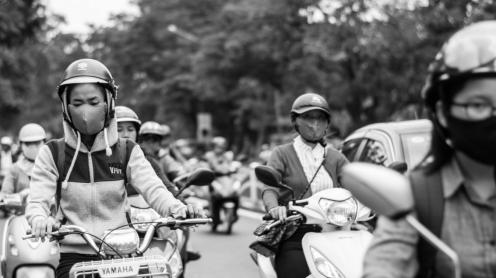Using data from French health centers from 2015 to 2016, years marked by terrorist attacks, a team of researchers found that depressive symptoms decreased as events unfolded.
January 7, 2015.This was the day when the Kouachi brothers attacked the editorial office of the satirical newspaper Charlie Hebdo, killing twelve people. We remember the horror caused by this outburst of violence, the demonstrations throughout France, and the slogan "Je suis Charlie" "I am Charlie". This attack was unfortunately only the first of a tragic succession of violent events that shook France between 2015 and 2016. Just ten months later, the Paris attacks killed 130 people near the Stade de France, in the Bataclan concert hall and in several bars and restaurants in the capital. On July 14 of the following year, a lorry ploughed through the Promenade des Anglais in Nice, killing 84 people. In France, according to the Global Terrorism Database, 212 attacks were recorded between 2012 and 2018, killing 286 people and injuring 1,003 others. In comparison, between 2000 and 2011, a period almost twice as long, 242 attacks had caused the death of 8 people and injured 90.
Using these three events, which were concentrated over a short period of time and affected the entire country, researchers Sylvie Blasco, Eva Moreno-Galbis and Jérémy Tanguy,in their research paper Getting used to terrorist threats? Evidence from French terrorist attacks between 2015 and 2016, tried to understand whether exposure to successive attacks leads populations to become accustomed to terrorist violence or whether, on the contrary, the impact on mental health worsens after each attack.
Video interview with Eva Moreno Galbis in connection with the article "We get used to terrorism!"
Depressive symptoms decline
Psychological research confirms that the effects of trauma on mental health decline when the individual is exposed to violent events several times. As these events occur, the body reduces the production of stress hormones. For the authors who have examined the issue, people who consciously continue to live in places that are at risk of hurricanes, floods or violent attacks demonstrate that the succession of disasters has only increased their resistance to stress. In psychology, this effect can be called habituation1.
On the contrary, other researchers have shown that if an individual had already experienced a trauma, then a new shock would amplify the response to this stress. This is called sensitization. For example, in their research on children who were victims of Hurricane Katrina in 20052, the researchers showed that they were more severely impacted mentally if they had already had a shock before, such as an accident or a divorce. One criticism that may be made about this research is that the questionnaire was conducted just after the disaster, based on old memories, and trauma other than a natural disaster.
- 1Andersen J. P., Silver R. C., Stewart B., Koperwas B., & Kirschbaum, C., 2013. "Psychological and physiological responses following repeated peer death". <em>PloS One</em>, <em>8</em>(9), e75881. Bleich A., Gelkopf M., & Solomon Z., 2003. "Exposure to Terrorism, Stress-Related Mental Health Symptoms, and Coping Behaviors Among a Nationally Representative Sample in Israel". <em>JAMA : the journal of the American Medical Association</em>, <em>290</em>, 612‑620.
- 2Kronenberg M. E., Hansel T. C., Brennan A. M., Osofsky H. J., Osofsky J. D., Lawrason, B.,2010,. "Children of Katrina : Lessons learned about postdisaster symptoms and recovery patterns". Child Development, 81(4), 1241‑1259.
The three researchers of Getting used to terrorist threats? Evidence from French terrorist attacks between 2015 and 2016 tried to understand whether the depressive symptoms observed after the events decreased or increased as the different attacks occurred. To do this, they used medical questionnaires, which include questions on mental health, taken from data from Constances, a generalist epidemiological cohort made up of a representative sample of 200,000 adults aged 18 to 69 consulting Social Security health examination centres. The CES-D3 mental health indicator proposed in the context of these examinations assesses the presence of depressive symptoms experienced by the patient during the previous week. The evaluation is done through 20 statements such as "I don't have confidence in the future," "I felt depressed," or "My sleep was not good".
The weekly data were analyzed five weeks before the attacks and up to six weeks after. They reveal a 1.7 point deterioration in mental health the week after the first attack, 0.9 for the week after the second attack and 1.3 three weeks later, while the third attack had no significant effect on mental health.
- 3The CES-D, Center for Epidemiologic Studies- Depression Scale, is based on 20 questions formulated in 1977 by Laurie Radloff to measure the severity of depressive symptoms in a population.
Discarded socio-demographic criteria
To understand the results obtained, the researchers characterized the three attacks in socio-demographic profiles. For example, is one more affected when the age of the victims of the attack is closer to one's own age group, thus allowing for strong identification? In the case of Charlie Hebdo, 47% of the victims were over 55 years old. In the Bataclan attacks, 80% were 18-40 years old, while 19% of the victims of the Nice attack were under 18. In addition to the age of the victims, the population was increasingly undifferentiated, ranging from journalists, to young Parisians, to entire families with no specific characteristics. However, the population studied suffered less from the last two attacks, regardless of their age. The researchers also looked for the impact of the Nice attacks on parents, who could have seen a reflection of their own offspring in the victims due to a similar young age. Yet the parents were also less affected by this latest attack. However, we note that they are on average more affected than the population without children by the three attacks, perhaps suggesting an attachment to life and therefore a stronger anxiety.
Geographical proximity could have been another possibility of identification with the victims. However, during the Charlie Hebdo attacks, it was mainly people living in the provinces who were affected. In Paris and Nice, the effect was the same, regardless of where people lived (Figure 2). Furthermore, the Centre de recherche pour l'étude et l'observation des conditions de vie4, Crédoc ,had found in 2016 that when the population was asked to name the terrorist acts committed in the world or in France, which have most affected them since the year 2000, 78% of respondents aged 25 to 39 cited attacks that took place abroad, not in France. The criterion of geographical proximity is therefore not relevant in this case.
- 4The research center for the study and observation of living conditions

Picture by Clément Falize onUnplash
The researchers were also interested in the community affiliation of the studied populations. In the Constances data, circumcision is mentioned, which allowed them to identify a group of Jewish or Muslim individuals. The former could have felt targeted by the attack on a kosher supermarket on January 8, 2015, the day after the attack on Charlie Hebdo, while the latter could have been negatively impacted by the rejection of a part of French society that associated their religion with terrorism. Limited by a small sample of 5,000 people, the results do not show a specific deterioration of mental health according to religious affiliation, thus distancing the community hypothesis.
Another socio-demographic criterion analyzed was media consumption, with the hypothesis that this could have modified the intensity of depressive symptoms. The researchers used a survey from the European Social Survey on the average time spent on a weekday watching news or politics on television. Using the socio-demographic data from this study on their own cohort, the researchers find that the volume of media ingested does not explain depressive symptoms after the occurrence of attacks. On the contrary, in the case of the Charlie Hebdo and the Paris attacks, the higher the media consumption, the lower the depressive symptoms, perhaps suggesting that people also become accustomed to images of violence.
Acting quickly and widely
It is therefore by discarding these socio-demographic hypotheses that the researchers conclude that the human body and brain become accustomed to the terrorist threat, and that this habituation is not linked to identification with the victims or media consumption. These results are not related to a better anticipation of the attacks either, because after an analysis of Google search trends, the words "attack", "terrorism" or "terrorist threat", were not typed into the search engine more often in the period preceding the last two attacks - only on the days of the attacks. The results must of course be interpreted with caution. The WHO tells us, for example, that one in five people in conflict zones suffers from mental disorders.
The recommendations concerning public health policies that can be drawn from this research are based on the importance of taking care of the mental health of the population, in conjunction with health professionals, immediately after the first disaster or attack, the one that will have the strongest impact. This requires the rapid and widespread deployment of support, via channels that reach the entire population (social networks, TV, etc.), since the population is affected in an indiscriminate manner, except for those who were directly or indirectly involved during the various attacks5.
- 5In an IMPACTS study published by Santé Publique, six months after the attacks, nearly 4 out of 10 people directly or indirectly exposed to the Paris attacks still had at least one mental health disorder.














